Cog L2 - Working Memory
1/58
Earn XP
Description and Tags
Year one
Name | Mastery | Learn | Test | Matching | Spaced |
|---|
No study sessions yet.
59 Terms
What is metatheory?
A set of assumptions and guiding principles
What are the stages of memory? (3)
Encoding → storage → retrieval

What is encoding?
process of placing new information in memory (changes into a form that can be stored)
What is storage? (1→2; 1)
concerns the nature of memory stores
where is it stored?
how long will it last? (duration)
how much can be stored? (capacity)
what kind of information is stored?
known as memory (info stored in some way for later use)
What is retrieval?
recovering stored information from memory

What are the 2 forms of retrieval? (think learning)
recall
recognition
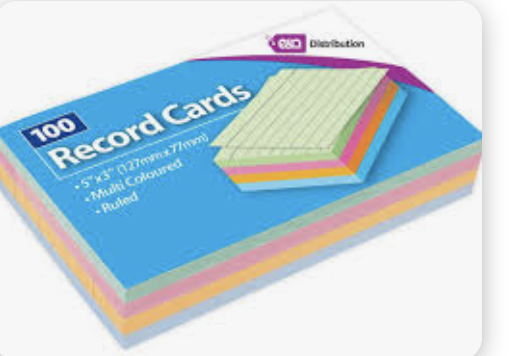
What is recall (form of retrieval)?
retrieve information from memory in response to a cue or question

What is recognition (form of retrieval)?
Refers to the ability to identify if encountered something before (ie. familiarity)
What does the Multi-store model do?
distinguish between short and long term memory
Features of the STM (5)
limited capacity
short duration
physical/sensory codes
trace decay/interference
prefrontal cortex
Features of the LTM
unlimited capacity
indefinte duration/permanent
meaning/semantic codes
cue dependent forgetting
hippocampus
Recall the MSM diagram:
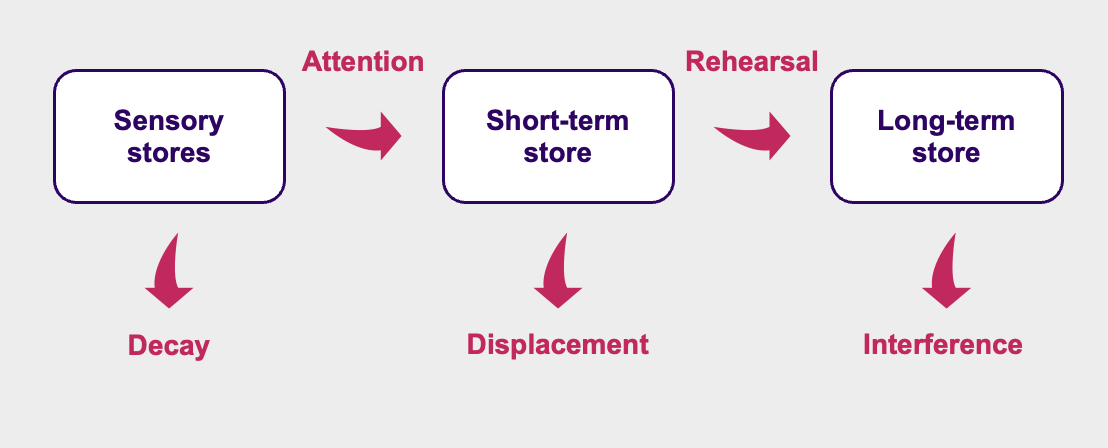
Who is named for speaking about the Multi-store model?
Atkinson & Shiffrin (1968)
What date is provided for the MSM?
1968
The sensory store is modality specific. True or False?
True
Features of the sensory store: (3)
modality specific
holds information briefly (1-2s)
attention occurs after information held in sensory stores (some info attended to is processed in the STM)
What are the two modalities of the sensory store for eyes and ears?
Iconic memory = visual store
Echoic memory = auditory store

Features of the short term store? (3)
very limited capacity (7 ± 2 - Miller (1956))
items vs chunks (integration of smaller units)
info lost via displacement

What is displacement?
when store is full, new info pushes out the old
What is the test for displacement?
Serial recall task
What is the serial recall task? and its result
recall items in exact sequence. memory advantage for first and last items

What is the reason for the result of the serial recall task
the first couple points - primacy (interference)
the last couple - recency (displacement)
What is primacy? (3)
involves long term memory
earlier items in list get full attention
slower presentation rate = longer time for attention, so more items remembered
What is recency? (3)
new items displace old items
last item = no new info
redundant suffix item at end of list disrupts recency
Features of the LTM: (4)
information transferred from short to long term store via rehearsal
unlimited capacity
stores info over a long time
info lost through interference
What is interference?
some memories hinder the retrieval of other memories
Strengths of the MSM: (2)
widely accepted that there are 3 distinct memory systems
evidence to support separate short and long term memory stores
Weaknesses of the MSM: (3)
Oversimplified as stores do not operate in a single, uniform way
cannot explain implicit learning (eg. a 5 year old knowing English w/out the understanding grammar rules)
information only transferred to LTM via rehearsal
Who is named for Levels of processing?
Craik & Lockhart (1972)
What is levels of processing? (2→1)
major challenge to multi-store approach
processes during learning determines information stored in LTM
memories are by-products of perception, attention and comprehension
Levels of processing range from…. (2)
shallow (or physical) analysis
appearance/sound based
deep (or semantic) analysis
info must have meaning
What are the 2 main assumptions of levels of processing?
level/depth effects memorability
deeper levels of analysis produce more elaborate, longer lasting and stronger memory traces
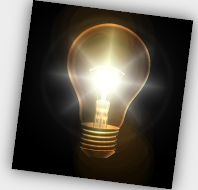
Who is named for the incidental learning task?
Craik & Tulving (1975)
What happened in the incidental learning test? (3)
ptps not told there would be a memory test
3 tasks
shallow-graphemic = word upper/lower case
intermediate-phonemic = word rhymes with target?
deep-semantic = word fits in sentence?
assessed recognition memory
performance 3x higher with deep than shallow processing
What did Morris et al (1977) do? (2)
2 learning tasks
shallow = rhyme
deep = semantic
2 recognition memory tests
standard = select list words from non-list words
rhyme = select words rhyming with list words
What did Morris et al (1977) find?
standard recognition test
usual superiority for deep processing
rhyme recognition test
superiority for shallow processing (opposite to levels of processing account!)
memory depends on the requirements of the memory test
successful retrieval requires that processing at time of learning is relevant to demands of the memory test
What is working memory?
Short-term memory used when performing complex tasks

What does working memory mean?
can undertake various processes at the same time
perform tasks not explicitly memory tasks (eg. mental arithmetic)
…. was replaced by the working memory
Short-term memory
Recall the working memory model diagram

Who is named for the Working Memory Model?
Baddeley (2012)
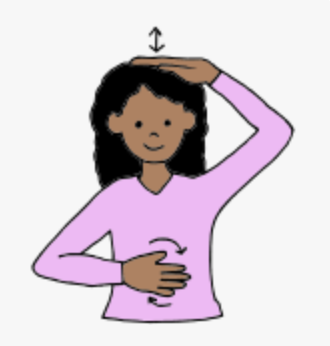
WMM: All components have limited capacity and work independently. What does this mean?
if 2 tasks use the same component, they can’t be performed concurrently
if 2 tasks used different components, possible to perform both equally well
What is the central executive?
resembles attentional system
most important and versatile component
associated with several executive* processes
focus attention / concentration processes
dividing attention between tasks
switching attention between tasks
interfacing with LTM
*those that organise and coordinate functioning of cognitive system to achieve current goals
What is the phonological store?
2 components:
phonological store = speech perception
articulatory loop = speech production (or rehearsal)
What has direct access to the store? why?
auditory word presentation
because it is already in the currency of the store (sound)
What has indirect access to the store and how? why?
visual word presentation - through the articulatory loop (speech production)
because it needs to be converted to the currency of the store (sound)
What is the phonological similarity effect?
poorer recall for similar sounding items than dissimilar ones
What does the phonological similarity effect do?
supports the notion that there’s a separate phonological store and articulatory loop…the role of articulatory suppression
Articulatory suppression….
…prevents rehearsal
What happens in modality dissociation?
auditory list = similarity effect is still present
visual list = similarity effect abolished
What is the Visuo-spatial sketchpad for?
the storage and manipulation of visual patterns and spatial movement
remembering what something is (visual)
remembering where something is (spatial)
What are the 2 components of the VSS? and which name is associated with this?
visual cache = stores info about visual form and colour
inner scribe = processes spatial and movement info
Logie (1995)

What did Smith & Jonides (1977) do?
provided 2 stimuli and a probe and ptps had to decide whether probe was in the same location (spatial) or form (visual) as one of the presented stimuli
What did Smith & Jonides (1977) find?
stimuli identical in both tasks (location or spatial Qs) but different brain activity (PET)
right hemisphere = spatial task
left hemisphere = visual task
suggests there are 2 separate systems processing visual and spatial output?
What does the episodic buffer do?
holds integrated information (or chunks) about episodes/events in multidimensional code (combo of visual, auditory, spatial, etc info)
a buffer between other slave systems (storage of verbal and visual/spatial info from others)
Does the central executive control access to the episodic buffer?
It’s debated
Recall Darling et al (2017) WMM diagram
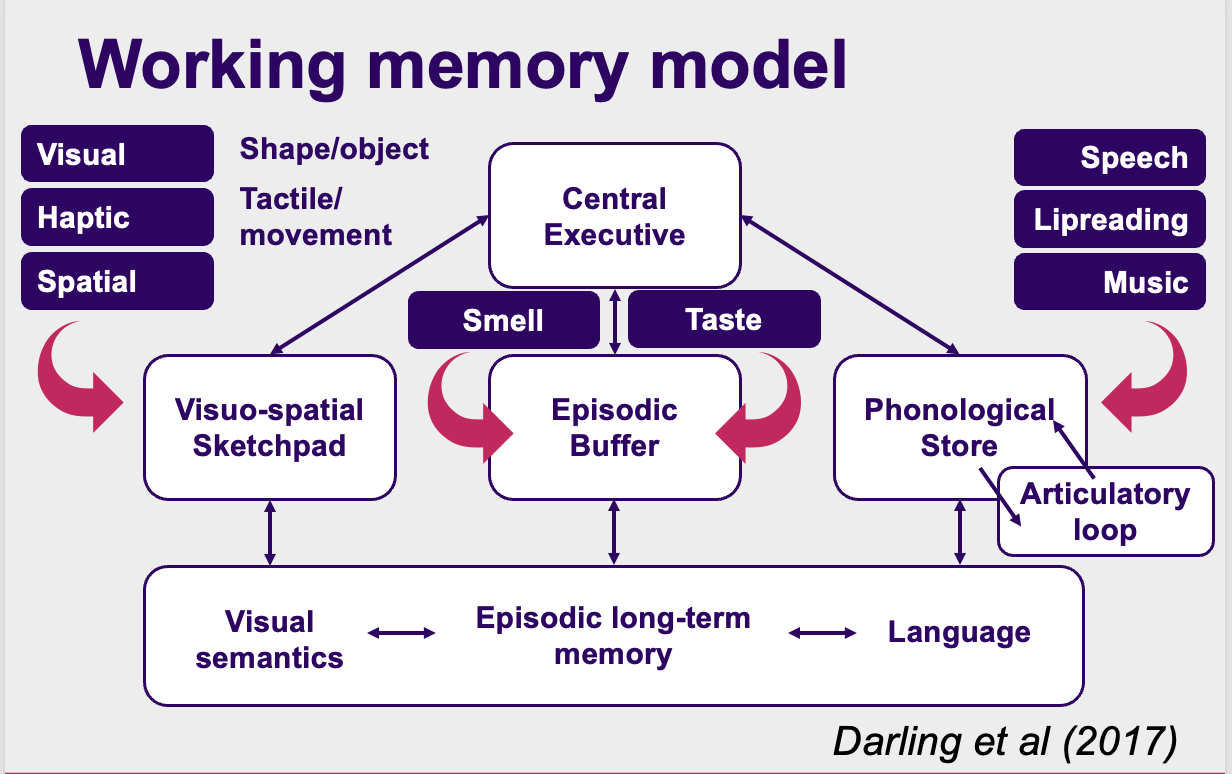
Visually presented words gain access to the phonological loop through….
…subvocal articulation